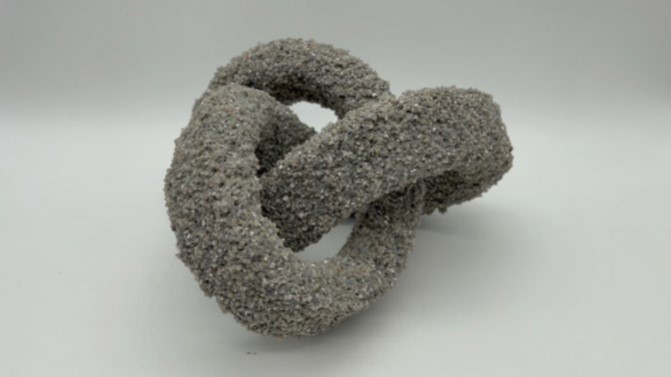Research Summary Report of A02
Particle-Bed 3D Printing by Selective Cement Paste Intrusion (SPI) – Particle Surface Functionalisation, Particle Synthesis and Integration of WAAM Reinforcement
[17.11.2023]
Straßer, Alexander, TP editor, alexander.strasser@tum.de, TUM, Chair of Materials Science and Testing
Kränkel, Thomas, TP editor, thomas.kraenkel@tum.de, TUM, Chair of Materials Science and Testing
Gehlen, Christoph, PL, gehlen@tum.de, TUM, Chair of Materials Science and Testing
The goal of A02 is to implement reinforcement by Wire and Arc Additive Manufacturing (WAAM) in concrete elements produced by Selective Paste Intrusion (SPI), see Figure 1. Since the cement paste is applied to the aggregates and must penetrate the cavities between the aggregates by gravity, consistent rheological properties of the cement paste are essential. The welding process with WAAM generates high temperatures – approx. 1500 °C at the welding point. This temperature load may harm the SPI process. Therefore, the impact of WAAM-induced temperature loads on the SPI-made concrete is analyzed and whether potential issues can be solved by various cooling strategies.
Summary
Various investigations were carried out. These included investigating the effect of the influence of temperature loads on the contact zone between reinforcing steel and concrete matrix or its bond strength.
Current state of research
In the previous report, it was mentioned that a series of tests was planned to investigate the influence of temperature loads on Wire Arc Additive Manufacturing (WAAM) steel regarding its fresh concrete or the contact zone between reinforcing steel and concrete matrix, as well as its bond strength. The results suggest that the bond strength only decreases at temperatures exceeding 100°C. However, the bond strengths were so high that the utilized steel ruptured during the pull-out test under tensile load, even before the bond between concrete and steel failed. More precise values, especially concerning bond work and associated slip, still need to be evaluated.
In collaboration with the TPs C02, C03, research associates and architecture students under the guidance of TT Professorship Digital Fabrication and Professorship Structural Design, a partnership was established. Our primary objective was the development of two demonstrators using Selective Paste Intrusion (SPI) technology. A big thank you to you for the great collaboration!
These demonstrators includes a 5-meter-long bridge and a 1:1 scale model section of a wall element. The bridge, due to its size, was fabricated by an external partner, while the wall element was produced in our own AMC Lab.
What sets the wall element apart is the consideration of cavities in the design, optimized by C03 to enhance thermal insulation with the clear goal of meeting the requirements of the ‘Gebäude Energie Gesetz’ (GEG). Porous expanded clay aggregate was used as aggregate in the particle bed.
This research opened the door for using alternative aggregates and demonstrated that other materials are also compatible with SPI technology. These findings hold significant importance and paved the way for a second funding period for our project. In this phase, we plan to investigate, among other things, eco-friendly concrete to further enhance the sustainability of our construction projects.










